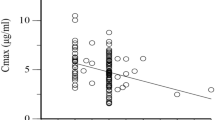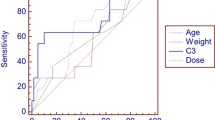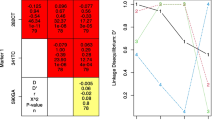Abstract
Background
Isoniazid (INH) is one of the most important drugs of antitubercular treatment regime, and in some cases it causes hepatotoxicity. It is metabolized by hepatic N-acetyltransferase-2 (NAT2).
Aim
To compare whether both methods, i.e., genotype NAT2 and phenotype test of measuring serum INH levels, are useful to identify acetylator status of patients on antitubercular treatment (ATT).
Methods
A total of 251 tuberculosis (TB) patients on standard treatment were followed up to 6 months for this study. NAT2 genotype was assessed by PCR with restriction fragment length polymorphism (RFLP) whereas serum INH levels were measured by fluorometry.
Results
Of the 251 patients, 50 (19.9%) developed ATT-induced hepatotoxicity. By phenotypic estimation, in the hepatotoxicity group, 17/50 (34%) were slow acetylators whereas 33/50 (66%) were fast acetylators. Genotypically, 19/50 (38%) were slow acetylators and 31/50 (62%) fast acetylators. By phenotypic analysis, in non-hepatotoxicity group, 46/201 (22.9%) were slow acetylators and 155/201 (77.1%) fast acetylators. By genotypic analysis, 30/201 (14.9%) were slow acetylators and 171/201 (85%) fast acetylators. Overall, slow acetylators (25.1%) measured phenotypically were not significantly different from slow acetylators (19.5%) measured genotypically.
Conclusion
This study suggests that the acetylator status of TB patients can be detected by phenotypic method as efficaciously as by genotypic method. Therefore, phenotypic method can replace genotypic method to determine acetylating status as phenotypic method is simple and inexpensive.


Similar content being viewed by others
References
Lee WM. Drug-induced hepatotoxicity. N Engl J Med 1995;333:11–18
Hwang SJ, Lee CN, Yen FS, et al. A prospective clinical study of isoniazid–rifampcin–pyrazinamide induced liver injury in an area endemic for hepatitis. Br J Gastroenterol Hepatol 1997;12:87–92
Tariq S, Khan TS, Malik S, Anwar MS, Rashid A. Frequency of anti-tuberculous therapy-induced hepaptotoxicity in patients and their outcome. J Ayub Med Coll Abbottabad 2009;21:50–52
Huang YS, Chern HD, Su WJ, et al. CytochromeP4502E1 genotype susceptibility to anti-tuberculosis drug induced hepatitis. Herpetology 2003;37:924–930
Tsuchida S, Sato K. Glutathione transferases and cancer. Crit Rev Biochem Mol Biol 1992;27:337–384
Mitchell JR, Zimmerman HJ, Ishak KG, et al. Isoniazid liver injury: clinical spectrum, pathology and probable pathogenesis. Ann Intern Med 1976;84:181–192
Farrell GC. Drug-induced acute hepatitis. In Farrell GC, editor. Drug-induced liver disease. Churchill Livingstone: Edinburgh; 1994. 247–99.
Ryan DE, Ramanathan L, Iida S, et al. Characterization of a major form of rat hepatic microsomal cytochrome P-450 induced by isoniazid. J Bio Chem 1985;260:6385–6393
Tao L, Xiang YB, Wang R, et al. Environmental tobacco smoke in relation to bladder cancer risk—the Shanghai bladder cancer study. Cancer Epidemiol Biomarkers Prev 2010;19:3087–3095
Rabstein S, Brüning T, Harth V, et al. N-acetyltransferase 2, exposure to aromatic and heterocyclic amines, and receptor-defined breast cancer. Eur J Cancer Prev 2010;19:100–109
Sun F, Chen Y, Xiang Y, Zhan S. Drug-metabolizing enzyme polymorphism and predisposition to anti-tuberculosis drug induced liver injury: a meta-analysis. Int J Tuberc lung Dis 2008;12:994–1002
Huang YS, Chern HD, Su WJ, et al. Polymorphism of the N-acetyltransferase 2 gene as a susceptibility risk factor of anti-tuberculosis drug-induced hepatitis. Hepatology 2002;35:883–889
Pande JN, Singh SPN, Khilnani GC, Khilnani S, Tandon RK. Risk factors for hepatotoxicity from antituberculosis drugs: a case–control study. Thorax 1996;51:132–136
Benichou C. Criteria of drug induced liver disorders: reform of international consensus meeting. J Hepatol 1990;11:272–276
Sud K, Muthukumar T, Singh B, et al. Isoniazid does not affect bioavailability of cyclosporine in renal transplant recipients. Methods Find Exp Clin Pharmacol 2000;22:647–649
Scott EM, Wright RC. Fluorimetric determination of isonicotinic acid hydrazide in serum. J Lab Clin Med 1967;70:353–360
Neughaur S, BabaT Watanabe T, Ishizaki T, Kurokawa K. An early risk marker for diabetic nephropathy in Japanese type 2 diabetic patients. Diabetic Med 1994;11:783–788
Suzuki H, Morris JS, Li Y, et al. Interaction of the cytochrome P4501A2, SULT1A1 and NAT gene polymorphisms with smoking and dietary mutagen intake in modification of the risk of pancreatic cancer. Carcinogenesis 2008;29:1184–1191
Rana SV, Pal R, Vaiphei K, Ola RP, Singh K. Hepatoprotection by carotenoids in isoniazid-rifampicin induced hepatic injury in rats. Biochem Cell Biol 2010;88:819–834
Evans DAP. N-acetyltransferase. Pharmacol Ther 1989;42:157–234
Mahmood K, Hussain A, Jairmani KL, et al. Hepatotoxicity with anti-tuberculosis drugs: the risk factors. Pak J Med Sci 2007;23:33–38
Ohno M, Yamaguchi I, Yamamoto I, et al. Slow N-acetyltransferase 2 genotype affects the incidence of INH and RMP induced hepatotoxicity. Intl J Tuberc Lung Dis 2000;4:256–261
Doll Ma, Fretland AJ, Deitz AC, Hein W. Determination of human NAT2 acetylator genotype by restriction fragment length polymorphism and allele- specific amplification. Anal Biochem 1995;231:413–418
Freguson RJ, Doll MA, Rustan TD, Gray K, Hein DW. Cloning, expression and functional characterization of two mutant (NAT2–191and NAT2–341/803) and wild-type human polymorphic N-acetyltransferase (NAT2) alleles. Drug Metabol Dispos 1994;22:371–376
Parthasarthy R, Sarma GR, Janardhanam B, et al. Hepatic toxicity in south Indian patients during treatment of tuberculosis with short-course regimens containing isoniazid, rifampicin and pyrazinamide. Tubercule 1986;67:99–108
Gurumurthi P, Kirshnamurthy MS, Nazareth O, et al. Lack of relationship between hepatic toxicity and acetylator phenotype in three thousand south Indian patients during treatment with isoniazid for tuberculosis. Am Rev Respir Dis 1984;129:58–61
Vatsis KP, Weber WW, Bel DA, et al. Nomenclature for N-acetyltransferase genetic polymorphism of cytochrome P4502E1 in Swedish population. Relationship to incidence of lung cancer. Pharmacogenesis 1995;5:1–20
Bose PD, Sarma MP, Medhi S, et al. Role of polymorphic N-acetyl transferase 2 and cytochrome P4502E1 gene in antituberculosis treatment-induced hepatitis. J Gastroenterology and Hepatology 2011;26:312–318
Díaz-Molina R, Cornejo-Bravo JM, Ramos-Ibarra MA. Genotypye and phenotype of NAT2 and the occurrence of adverse drug reaction in Mexican individuals to an isonizid-based prophylactic chemotherapy for tuberculosis. Mol Med Rep 2008;1:875–879
Singh N, Dubey S, Chinnaraj S, Golani A, Maitra A. Study of NAT2 gene polymorphisms in an Indian population: association with plasma isoniazid concentration in a cohort of tuberculosis patients. Mol Diag Ther 2009;13:49–58
Acknowledgements
Financial assistance by ICMR to carry out this research work is acknowledged.
Conflict of interest
Nothing is to disclose.
Author information
Authors and Affiliations
Corresponding author
Rights and permissions
About this article
Cite this article
Rana, S.V., Ola, R.P., Sharma, S.K. et al. Comparison between acetylator phenotype and genotype polymorphism of n-acetyltransferase-2 in tuberculosis patients. Hepatol Int 6, 397–402 (2012). https://doi.org/10.1007/s12072-011-9309-4
Received:
Accepted:
Published:
Issue Date:
DOI: https://doi.org/10.1007/s12072-011-9309-4




